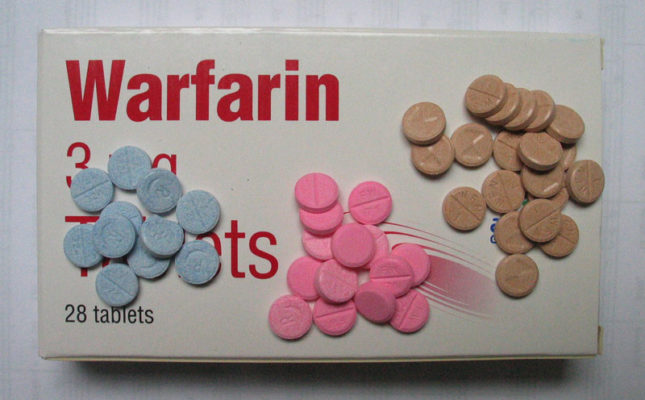Like many modern-day medicines, rodenticides are often derived from natural sources. Plants may evolve toxic chemicals to protect them from grazers for example, and sometimes all that distinguishes a beneficial drug from a toxic poison is the dosage.

In a recent issue of the NZ Journal of Zoology, Charles Eason, ecologist with Lincoln University (Lincoln) and the Cawthron Institute (Nelson), looks at the connections between naturally derived rodenticides and drugs. It’s a fascinating review.
Did you know, for example, that natural products have inspired 60% of today’s drugs and biocides, including rodenticides. Warfarin was one of the earliest anticoagulant rodenticides, introduced in 1947. Before newer synthetic oral anticoagulants were developed, warfarin was also the ‘medicine of choice’ for an estimated 1% of the population and 8% of over-80-year-olds.
Doctors prescribing rat poison? It’s all about the dosage – as Paracelsus figured out as long ago as the 16th Century, stating: ‘Solely the dose determines that a thing is or is not a poison’.

Warfarin and brodifacoum (now the most widely used rodenticide worldwide) are related to a naturally occurring substance – coumarin – discovered when scientists back in the 1930s investigated the causes of haemorrhagic syndrome in cattle that had eaten mouldy sweet clover.
“Research funded by the Wisconsin Alumni Research Foundation (ie WARF), led to exploration of dicoumarol and coumarin derivatives between 1946 and 1948. Warfarin, number 42 out of a total of 150 synthesised analogues, was particularly active and became a successful rodenticide.”
When warfarin was first proposed as a medicine, it’s history as a poison caused some understandable concerns, but that didn’t stop US President Eisenhower being one of it’s early recipients.
Cholecalciferol is another medicine/rat poison – and again it’s the dosage that makes the difference. Cholecalciferol is, in fact, vitamin D3 and deficiencies in the compound can cause ill-health, including rickets. It’s also a common treatment for osteoporosis. But at very high dosages it’s toxic and it is registered for possum and rat control in New Zealand.
“At toxic doses, this active metabolite mobilises calcium stores from bones into the bloodstream, and decreases calcium excretion by the kidneys to such an extent that rodents receiving a lethal dose usually die within 4-7 days as a result of hypercalcaemia, tissue calcification and renal or cardiac failure.”
Cholecalciferol has some advantages as well.
“For example, cholecalciferol is far less toxic to birds than rodents.”
So what about 1080? Fluoroacetate is another toxic agent produced by plants to deter grazers? Could it have medical benefits yet to be discovered? It turns out that 1080 may have potential uses in the detection and treatment of some cancers.
“Fluoroacetate has been identified as the toxic agent in many poisonous plants native to South America, as well as Africa and some 40 plant species in Australia. In relation to sodium fluoroacetate (1080) use for the control of unwanted introduced animals in New Zealand, research has focused on mode of action, sub-lethal effects, welfare, reducing its risk to non-target species and fate in the environment following use in baits. Toxicology studies have determined that the mechanism of toxicity for naturally occurring fluoroacetate and for 1080 in bait is the same. Both forms are equally poisonous.”
In fact, fluoroacetate may be more widespread in the plant kingdom than we realise.
“… Fluoroacetate occurs at extremely low concentrations in some Finnish plants, in tea leaves and guar gum. Research testing 10 common varieties of tea available in New Zealand showed fluoroacetate concentrations of 0.4-2.4 ng/cup.”
So what about its medical potential?
“Recently, sodium fluoroacetate has been explored for experimental use in radiology and metabolic/molecular imaging using positron emission tomography emitters, which is a growth area in radiology for cancer imaging… the amounts required for diagnostic imaging are extremely small and similar to those that might be ingested in tea.”
On a historical note – utilising ‘poisons’ for medical benefits is certainly nothing new. Strychnine (found in the seeds of the tree Strychnos nux-vomica), was not only a rat poison (used since mid-1800s), but also used in the late 19th Century as an athletic performance-enhancing drug. In the early 20th Century, it was also used in low doses as a tonic. It’s inhumaneness and persistence in the environment, has, however led to it being phased out as a vertebrate poison in modern-day New Zealand.
Research continues to discover what other useful compounds might have already been invented by plants.
“At the Cawthron Institute, in Nelson, New Zealand, natural compounds are being evaluated from marine organisms, including shellfish and seaweeds and a unique collection of over 300 micro-algae, and while some of these compounds have medical applications, some are potential biocides and vertebrate pesticides of the future. Portimine is one example of a natural marine compound that has unique anticancer properties and is also being explored as a biocide.”
What’s more, some potential rodenticides are highly potent.
“Their potency means that very small amounts would be used in baits; hence taste avoidance and bait shyness, which occur with many rodenticides, would be unlikely. This could be particularly helpful when developing rodenticides effective for the control of mice, which are easily deterred from eating baits, and compared with rats are more susceptible to anticoagulants.”
The full review article is published in the New Zealand Journal of Zoology. Only the abstract is freely available online, but readers who don’t have institutional online access, may be able to read a physical copy of the journal at their local library or request a copy through Researchgate.

